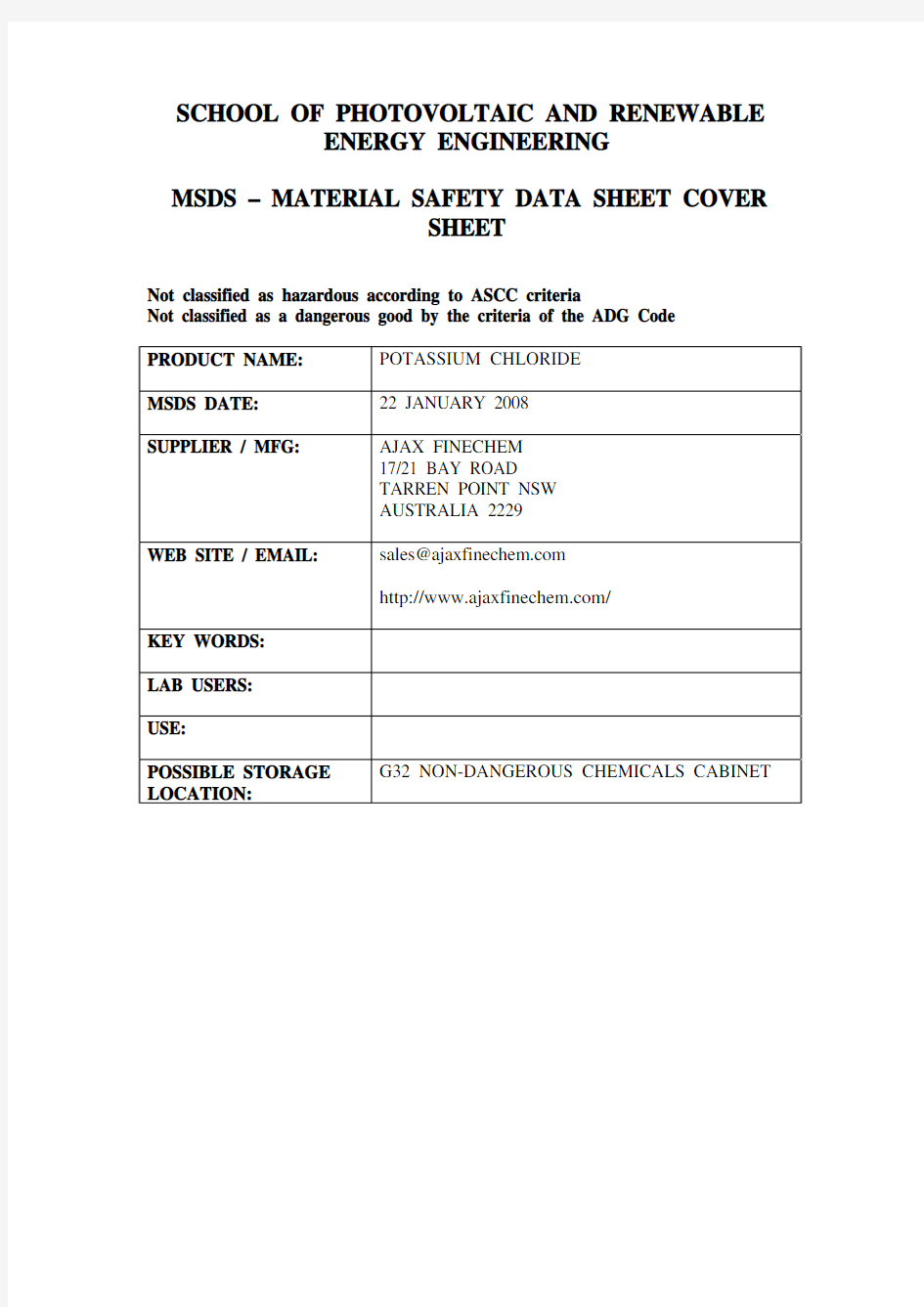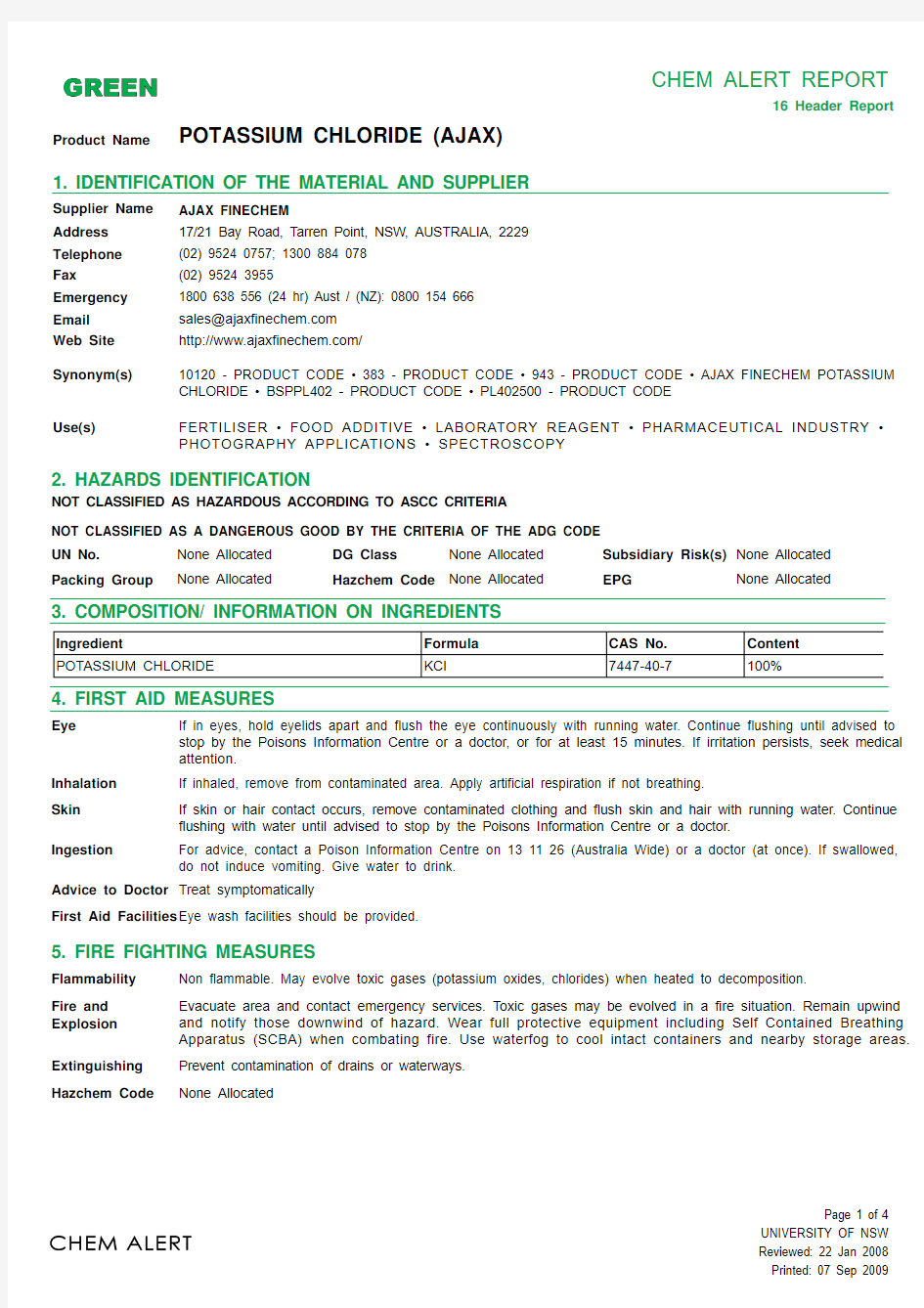

SCHOOL OF PHOTOVOLTAIC AND RENEWABLE
ENERGY ENGINEERING
MSDS – MATERIAL SAFETY DATA SHEET COVER
SHEET
Not classified as hazardous according to ASCC criteria
Not classified as a dangerous good by the criteria of the ADG Code PRODUCT NAME: POTASSIUM CHLORIDE
MSDS DATE: 22 JANUARY 2008
SUPPLIER / MFG: AJAX FINECHEM
17/21 BAY ROAD
TARREN POINT NSW
AUSTRALIA 2229
WEB SITE / EMAIL: sales@https://www.doczj.com/doc/4115069291.html,
https://www.doczj.com/doc/4115069291.html,/
KEY WORDS:
LAB USERS:
USE:
G32 NON-DANGEROUS CHEMICALS CABINET POSSIBLE STORAGE
LOCATION:
1. IDENTIFICATION OF THE MATERIAL AND SUPPLIER
17/21 Bay Road, Tarren Point, NSW, AUSTRALIA, 2229(02) 9524 0757; 1300 884 0781800 638 556 (24 hr) Aust / (NZ): 0800 154 666(02) 9524 3955
sales@https://www.doczj.com/doc/4115069291.html, https://www.doczj.com/doc/4115069291.html,/
AJAX FINECHEM
FERTILISER ? FOOD ADDITIVE ? LABORATORY REAGENT ? PHARMACEUTICAL INDUSTRY ?PHOTOGRAPHY APPLICATIONS ? SPECTROSCOPY
10120 - PRODUCT CODE ? 383 - PRODUCT CODE ? 943 - PRODUCT CODE ? AJAX FINECHEM POTASSIUM CHLORIDE ? BSPPL402 - PRODUCT CODE ? PL402500 - PRODUCT CODE
Fax Supplier Name Address Telephone Emergency Email Web Site Synonym(s)
Use(s)
NOT CLASSIFIED AS HAZARDOUS ACCORDING TO ASCC CRITERIA
2. HAZARDS IDENTIFICATION
NOT CLASSIFIED AS A DANGEROUS GOOD BY THE CRITERIA OF THE ADG CODE None Allocated None Allocated None Allocated None Allocated
None Allocated
None Allocated
UN No.Packing Group
DG Class Hazchem Code
Subsidiary Risk(s)EPG
3. COMPOSITION/ INFORMATION ON INGREDIENTS
Ingredient
Formula CAS No.
Content
POTASSIUM CHLORIDE
KCl
7447-40-7
100%
4. FIRST AID MEASURES
Fire and Explosion Evacuate area and contact emergency services. Toxic gases may be evolved in a fire situation. Remain upwind and notify those downwind of hazard. Wear full protective equipment including Self Contained Breathing Apparatus (SCBA) when combating fire. Use waterfog to cool intact containers and nearby storage areas.Extinguishing Prevent contamination of drains or waterways.Flammability Non flammable. May evolve toxic gases (potassium oxides, chlorides) when heated to decomposition.
Hazchem Code
None Allocated
5. FIRE FIGHTING MEASURES
Spillage
If spilt (bulk), use personal protective equipment. Contain spillage, then collect and place in suitable containers for disposal. Avoid generating dust.
Handling
Store in a cool, dry, well ventilated area, removed from oxidising agents and foodstuffs. Ensure containers are adequately labelled, protected from physical damage and sealed when not in use.
Storage Before use carefully read the product label. Use of safe work practices are recommended to avoid eye or skin contact and inhalation. Observe good personal hygiene, including washing hands before eating. Prohibit eating,drinking and smoking in contaminated areas.
6. ACCIDENTAL RELEASE MEASURES
7. STORAGE AND HANDLING
8. EXPOSURE CONTROLS/ PERSONAL PROTECTION
Exposure Stds No exposure standard(s) allocated.No biological limit allocated.
Biological Limits Engineering Controls Avoid inhalation. Use in well ventilated areas. Where an inhalation risk exists, mechanical extraction ventilation is recommended.
Wear dust-proof goggles, neoprene or nitrile gloves and coveralls. Where an inhalation risk exists, wear: a Class
P1 (Particulate) respirator. With prolonged use, wear: cotton or rubber or PVC gloves and coveralls.
PPE
9. PHYSICAL AND CHEMICAL PROPERTIES
Appearance WHITE SOLID Solubility (Water)SOLUBLE Odour SLIGHT ODOUR Specific Gravity 1.984
pH
7 (Approximately)% Volatiles NOT AVAILABLE Vapour Pressure NOT AVAILABLE Flammability NON FLAMMABLE Vapour Density NOT AVAILABLE Flash Point
NOT RELEVANT Boiling Point NOT AVAILABLE Upper Explosion Limit NOT RELEVANT Melting Point 773°C
Lower Explosion Limit
NOT RELEVANT
Evaporation Rate NOT AVAILABLE Sublimation Temperature
1500°C
Chemical Stability Stable under recommended conditions of storage.Conditions to Avoid
Avoid heat, sparks, open flames and other ignition sources.
10. STABILITY AND REACTIVITY
Material to Avoid Incompatible (potentially explosive) with oxidising agents (eg. hypochlorites).Decomposition May evolve toxic gases (potassium oxides, chlorides) when heated to decomposition.Hazardous Reactions
Polymerization will not occur.
Health Hazard Summary Low toxicity. Use safe work practices to avoid eye or skin contact and inhalation. Acute potassium poisoning via ingestion is rare as a large single dose usually induces vomiting, and potassium is rapidly excreted by the body,however this product does have the potential to cause cardiovascular disorders.Eye Low to moderate irritant. Contact may result in irritation, lacrimation, pain and redness.Inhalation Low irritant. Over exposure may result in irritation of the nose and throat, with coughing.Skin Low irritant. Prolonged or repeated contact may result in mild irritation, rash and dermatitis.
Ingestion
Low toxicity. Ingestion may result in gastrointestinal irritation, nausea, vomiting, abdominal pain and diarrhoea.Ingestion of large quantities may result in blood clotting changes, cardiac arrhythmias, increased respiration,muscle weakness, convulsions and coma.Toxicity Data
POTASSIUM CHLORIDE (7447-40-7) LD50 (Ingestion): 1500 mg/kg (mouse) LD50 (Intraperitoneal): 620 mg/kg (mouse) LD50 (Intravenous): 117 mg/kg (mouse) LDLo (Ingestion): 20 mg/kg (man)
LDLo (Intraperitoneal): 900 mg/kg (guinea pig) LDLo (Intravenous): 77 mg/kg (guinea pig) LDLo (Subcutaneous): 2120 mg/kg (frog) TDLo (Ingestion): 60 mg/kg/days (woman)
11. TOXICOLOGICAL INFORMATION
Environment
Limited ecotoxicity data was available for this product at the time this report was prepared. Ensure appropriate measures are taken to prevent this product from entering the environment.
12. ECOLOGICAL INFORMATION
Waste Disposal Collect and place in sealable containers and dispose of to an approved landfill site. Contact the manufacturer for additional information.
Legislation
Dispose of in accordance with relevant local legislation.
13. DISPOSAL CONSIDERATIONS
14. TRANSPORT INFORMATION
NOT CLASSIFIED AS A DANGEROUS GOOD BY THE CRITERIA OF THE ADG CODE None Allocated None Allocated None Allocated None Allocated
None Allocated
None Allocated
Shipping Name UN No.Packing Group
DG Class Hazchem Code
Subsidiary Risk(s)EPG
None Allocated Poison Schedule A poison schedule number has not been allocated to this product using the criteria in the Standard for the Uniform Scheduling of Drugs and Poisons (SUSDP).
AICS
All chemicals listed on the Australian Inventory of Chemical Substances (AICS).
15. REGULATORY INFORMATION
Additional Information
RESPIRATORS: In general the use of respirators should be limited and engineering controls employed to avoid exposure. If respiratory equipment must be worn ensure correct respirator selection and training is undertaken.Remember that some respirators may be extremely uncomfortable when used for long periods. The use of air powered or air supplied respirators should be considered where prolonged or repeated use is necessary.ABBREVIATIONS:ADB - Air-Dry Basis.
BEI - Biological Exposure Indice(s)
CAS# - Chemical Abstract Service number - used to uniquely identify chemical https://www.doczj.com/doc/4115069291.html,S - Central Nervous System.
EINECS - European INventory of Existing Commercial chemical Substances.IARC - International Agency for Research on Cancer.M - moles per litre, a unit of concentration.
16. OTHER INFORMATION
mg/m3 - Milligrams per cubic metre.
NOS - Not Otherwise Specified.
NTP - National Toxicology Program.
OSHA - Occupational Safety and Health Administration.
pH - relates to hydrogen ion concentration using a scale of 0 (high acidic) to 14 (highly alkaline).
ppm - Parts Per Million.
RTECS - Registry of Toxic Effects of Chemical Substances.
TWA/ES - Time Weighted Average or Exposure Standard.
HEALTH EFFECTS FROM EXPOSURE:
It should be noted that the effects from exposure to this product will depend on several factors including: frequency
and duration of use; quantity used; effectiveness of control measures; protective equipment used and method of
application. Given that it is impractical to prepare a Chem Alert report which would encompass all possible
scenarios, it is anticipated that users will assess the risks and apply control methods where appropriate.
PERSONAL PROTECTIVE EQUIPMENT GUIDELINES:
The recommendation for protective equipment contained within this Chem Alert report is provided as a guide only.
Factors such as method of application, working environment, quantity used, product concentration and the
availability of engineering controls should be considered before final selection of personal protective equipment is
made.
COLOUR RATING SYSTEM: RMT has assigned all Chem Alert reports a colour rating of Green, Amber or Red for
the sole purpose of providing users with a quick and easy means of determining the hazardous nature of a
product. Safe handling recommendations are provided in all Chem Alert reports so as to clearly identify how users
can control the hazards and thereby reduce the risk (or likelihood) of adverse effects. As a general guideline, a
Green colour rating indicates a low hazard, an Amber colour rating indicates a moderate hazard and a Red colour
rating indicates a high hazard.
While all due care has been taken by RMT in the preparation of the Colour Rating System, it is intended as a
guide only and RMT does not provide any warranty in relation to the accuracy of the Colour Rating System. As far
as is lawfully possible, RMT accepts no liability or responsibility whatsoever for the actions or omissions of any
person in reliance on the Colour Rating System.
Report Status This Chem Alert report has been independently compiled by RMT's scientific department utilising the original Material Safety Data Sheet ('MSDS') for the product provided to RMT by the manufacturer. The information is
based on the latest chemical and toxicological research and is believed to represent the current state of
knowledge as to the appropriate safety and handling precautions for the product at the time of issue.
This Chem Alert report does not constitute the manufacturer's original MSDS and is not intended to be a
replacement for same. It is provided to subscribers of Chem Alert as a reference tool only, is not all-inclusive and
does not represent any guarantee as to the properties of the product. Further clarification regarding any aspect of
the product should be obtained directly from the manufacturer.
While RMT has taken all due care to include accurate and up-to-date information in this Chem Alert report, it does
not provide any warranty as to accuracy or completeness. As far as lawfully possible, RMT accepts no liability for
any loss, injury or damage (including consequential loss) which may be suffered or incurred by any person as a
consequence of their reliance on the information contained in this Chem Alert report.
Prepared By Risk Management Technologies
5 Ventnor Ave, West Perth
Western Australia 6005
Phone: +61 8 9322 1711
Fax: +61 8 9322 1794
Email: info@https://www.doczj.com/doc/4115069291.html,.au
Web: https://www.doczj.com/doc/4115069291.html,.au
Last Reviewed:22 Jan 2008
Date Printed:07 Sep 2009
End of Report